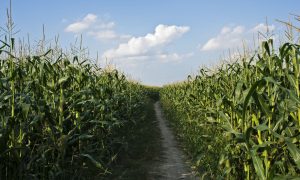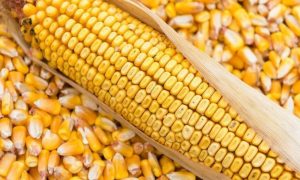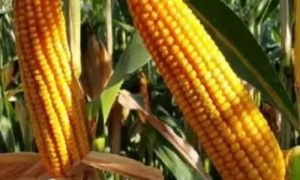Biomethane produced from maize grown on peat emits more CO2 than natural gas

Biomethane production from maize on peatlands, while beneficial for climate mitigation, can result in high CO2 emissions due to peat oxidation. In the UK, soil CO2 emissions from maize on peat are significantly higher than the CO2 savings from substituting natural gas. This indicates that cultivating maize for biomethane on peat may not be climate-friendly.
Biomethane is the main fuel component of biogas, a mixture of methane (CH4) and carbon dioxide (CO2), produced by means of anaerobic digestion of organic matter. Production of biomethane as fuel has increased fourfold since 2000. A principal driver of this increase has been the climate mitigation benefits of generating energy from materials such as food and livestock waste or recently photosynthesized crop biomass, such that the net emission of CO2 to the atmosphere is close to zero. The bioenergy industry estimates that biomethane production via anaerobic digestion has the potential to reduce GHG emissions by 10–13% and meet 6–9% of global primary energy demand. To achieve these amounts, however, it will be necessary to greatly expand the cultivation of feedstocks such as maize (Zea mays) grown specifically for biomethane production to occupy ∼7% of the present global agricultural land area.
The assumption of low emissions from crop-based biomethane depends critically on the carbon balance of the land on which the crop is grown. On a mineral soil, it is reasonable to assume an approximately neutral carbon balance, with the export of recently assimilated carbon in harvested biomass having little impact on the long-term soil carbon balance. Where crops are grown on peat, however, this assumption does not hold. All forms of conventional agriculture on peat require drainage, exposing peat to oxidation and driving rapid and sustained soil CO2 emissions. Cultivated peatlands are estimated to have the highest GHG emission intensity of any agricultural land globally, generating 2–3% of all anthropogenic GHG emissions.
In addition to food production, drained peatlands are increasingly used to produce biomass for bioenergy. Biodiesel derived from palm oil produced on tropical peat may result in 3–40 times more GHG emissions than fossil diesel. This finding led the US Environmental Protection Agency to exclude biodiesel derived from palm oil as a renewable fuel in 2011 and the European Union to recently announce a phase-out of palm oil in biofuels by 2030. So far, however, production of biomethane feedstock crops on peat, notably in Europe, has not received such critical attention.
Taking the United Kingdom as a case study, the area of maize cultivation on drained peat (>40 cm) and peaty soils (soils with <40 cm of peat remaining as a result of long-term wastage) has risen from ∼6,000 ha in 2015 (the first year for which national activity data are available) to >11,000 ha in 2020–2021. Over the same period, the proportion of UK maize grown for biomethane production increased from 20% to 34%. Assuming that the fraction of maize grown on peat being used for this purpose corresponds with the UK national average, this represents a threefold increase in maize cultivation for biogas on peat soils. Contributory factors in this growth have been government financial support for biogas production through the Renewable Heat Incentive (2011–2021) and Green Gas Support Scheme (2021–2025), policies that are intended to support energy sector decarbonization.
UK Government conversion factors for embodied GHG emissions in biogas (0.001 kgCO2e m−3 of gas with a 65% CH4 content) compare highly favourably to those associated with natural gas (2.05 kgCO2e m−3) (ref. ). The biomethane figure is based on a mixed waste and crop feedstock but excludes any soil CO2 emissions from crop cultivation. Our data, obtained from field-scale measurements of drained peat under rotational cropping show that soil CO2 emissions under maize crops are consistently high (19.2–28.1 tCO2 ha−1 yr−1) and similar to those for food crops grown in the same rotation (wheat and lettuce, 22.2–27.6 tCO2 ha−1 yr−1) (Fig. 1). We therefore conclude that maize (and similar bioenergy crops) grown on peat probably generate similar soil CO2 emissions to other food crops grown on the same soil and with the same drainage. On this basis, we applied the UK country-specific (Tier 2) emission factors (EFs) for cropland on peat of 27.1 (95% confidence interval 9.6–44.5) tCO2 ha−1 yr−1 for cropland on deeper peat (>40 cm) and 16.0 (10.2–21.8) tCO2 ha−1 yr−1 for cropland on thinner peaty soils. The Intergovernmental Panel on Climate Change (IPCC) ‘Tier 1’ CO2 EF for cropland on drained temperate peat soils 29.0 (23.8–34.5) tCO2 ha−1 yr−1 (ref. ) is very similar to the UK Tier 2 figure for peat >40 cm, indicating that our calculations are applicable to temperate regions in general.
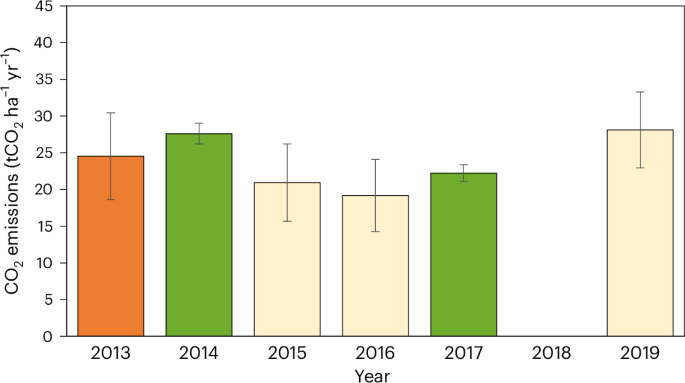
To calculate avoided emissions from substituting maize-derived biomethane for natural gas, we applied an average dry matter (DM) yield for UK-grown maize of 13.5 tDM yr−1, along with published data on biogas yield and methane content from maize feedstocks, giving an estimated biomethane yield of 4,484 m3 CH4 ha−1 yr−1. We assumed that maize yields do not vary systematically by soil type. Combined with the UK Government’s conversion factor for natural gas of 2.05 kgCO2e m−3, this produces a maximum ‘avoidable’ fossil CO2 emission, per unit area of maize cultivation, of 9.2 tCO2 ha−1 yr−1. This can be considered an effective break-even point for soil-derived CO2 emissions; for maize-derived biomethane to have a lower warming impact than natural gas, soil emissions must be lower than this value. This is not the case for maize grown on peat soils: based on the Tier 2 EFs above we calculate that CO2 emissions from thin peaty soils used to grow maize for anaerobic digestion are (depending on yields) ∼1.7 times higher than the avoided fossil CO2 emission from the resulting biomethane (Fig. 2). For thicker peat soils, this figure rises to 2.9. If we take the IPCC Tier 1 EF for cropland on drained organic soils, biogas derived from maize grown on peat is estimated to emit 3.2 times more CO2 than natural gas. Expressing the UK figures in terms of the biomethane produced, we calculate embodied soil CO2 emissions of 3.6 kgCO2 m−3 where maize feedstock is grown on thin peaty soils and 6.0 kgCO2 m−3 where it is grown on thicker peat, relative to the avoided natural gas emission of 2.05 kgCO2 m−3.
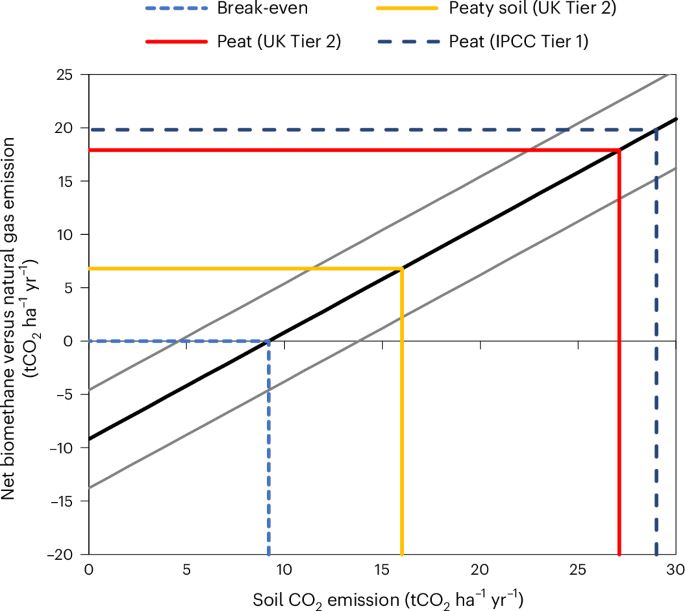
Our analysis is not a full life-cycle analysis of biomethane production relative to that of natural gas. However, previous life-cycle analyses for maize-based biomethane production systems give estimates of 1.1–2.6 kg CO2 m−3 CH4 . These figures, incorporating emissions from fertilizer production, field nitrous oxide (N2O) emissions, fuel use during production and transport, fugitive CH4 emissions from anaerobic digestion plants and disposal of digestate, are thus smaller in total than our single soil CO2 emission value for maize grown on peat; the missing piece of the jigsaw is larger than the rest of the jigsaw combined. Including elevated non-CO2 GHG emissions from peatlands under crop cultivation, including high nitrous oxide (N2O) emissions from peat oxidation and CH4 emissions from drainage ditches, would further increase emissions associated with maize-production on peat.
On the other hand, it could be argued that the counterfactual for drainage-based cultivation of biogas maize on peat is drainage-based cultivation of food crops, with the same field-scale GHG emissions. Where maize cultivation is integrated into the food production system, for example as the break crop in a vegetable rotation, biogas production could even be considered to offset some of the emissions from that system. However, many countries (including the United Kingdom) are seeking to reduce the area of peatland under cultivation and to reduce drainage intensity within remaining cultivated, in pursuit of net-zero emission targets. These targets are likely to place increasing pressure on domestic food production and risk simply displacing the GHG emissions and other environmental costs of food production if they drive an increased reliance on food imports. In this context, it does not seem wise to use land primarily for bioenergy generation, in circumstances where the bioenergy has a higher embodied CO2 emission than the fossil fuel it replaces. Furthermore, estimated GHG emissions reductions from rewetting formerly drained cropland (32 and 21 tCO2e ha−1 yr−1 for peat and peaty soils, respectively, UK Tier 2 EFs) far exceed the emissions reductions that could be achieved by using the same land for maize-based biogas production and can therefore be expected to generate greater long-term climate mitigation benefit.
Although our analysis focuses on maize and on the UK as a case study, our conclusions apply to all bioenergy crops grown on drained peat and to all countries in which they are or could be grown. Our results do not imply that all forms of bioenergy production on peat will lead to increased emissions; indeed, the production of dedicated biomass crops on agricultural peatlands managed with higher water levels (often termed ‘paludiculture’) holds promise for effective climate mitigation and is potentially compatible with bioenergy production. However, we recommend that all bioenergy projects on peat should account for GHG emissions from peat drainage and particularly the break-even point at which soil GHG emissions exceed the avoided emissions of the bioenergy. This will vary according to soil type, crop yield and energy yield, as illustrated by Fig. 2, as well as the type of fossil fuel substituted and may be mitigated through changes in land management such as raised water levels. This is urgent: our analysis suggests that renewable energy incentives, seeking to expand biogas production to meet net-zero goals, have led to the expansion of feedstock production onto drained peat soils and a resulting increase in energy system GHG emissions. Recent initiatives that combine crop-based biogas with carbon capture and storage are highly unlikely to produce ‘carbon negative’ energy if implemented on peat.
To read more about the news about the Maize News continue reading Agriinsite.com
Source Link : https://www.nature.com/articles/s41558-024-02111-1

